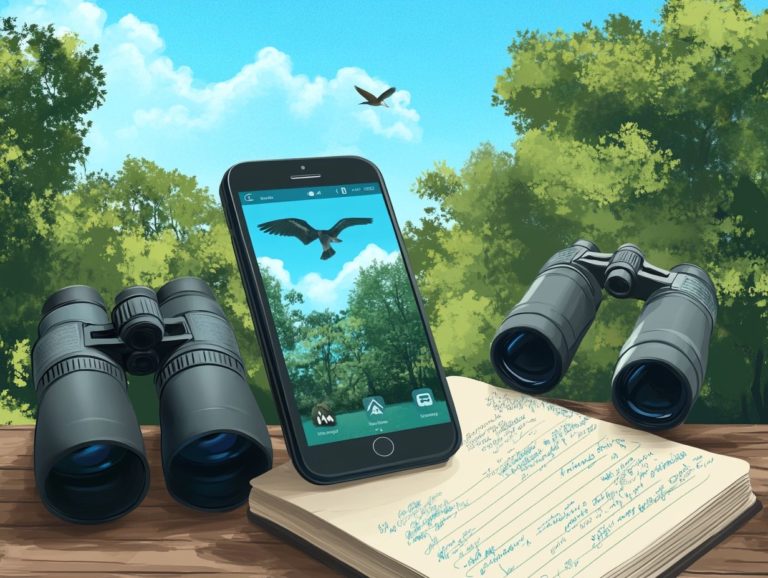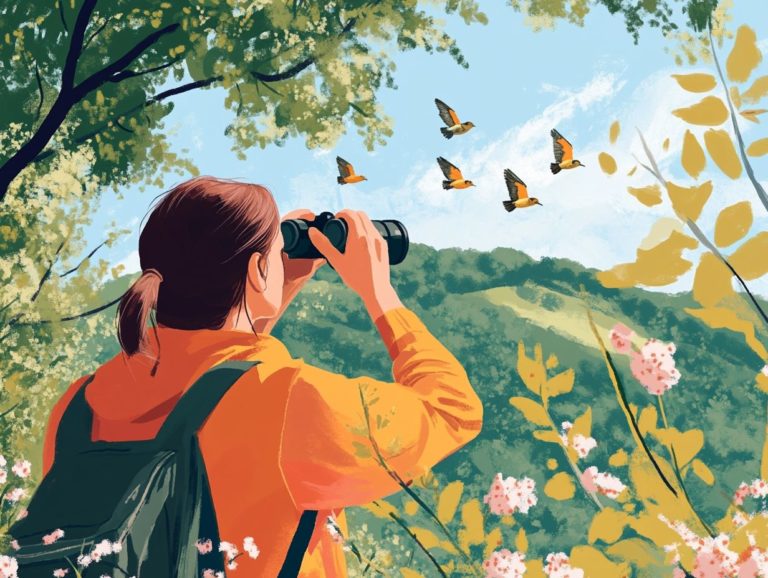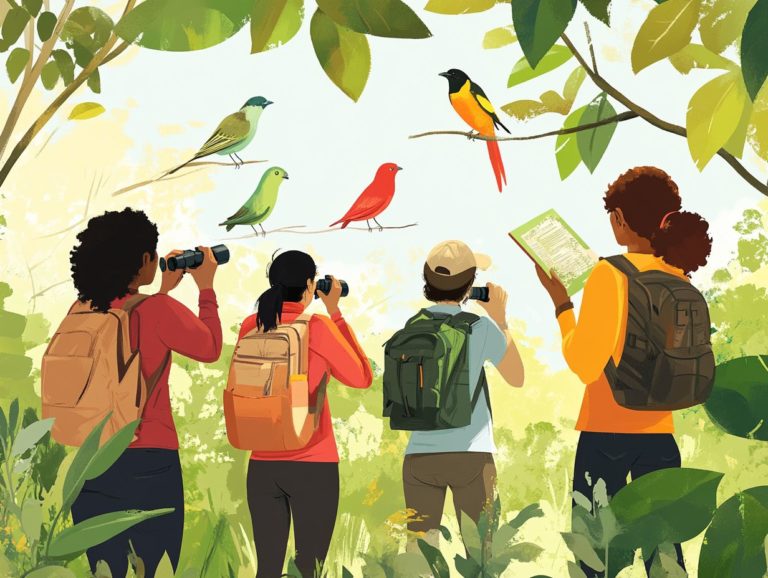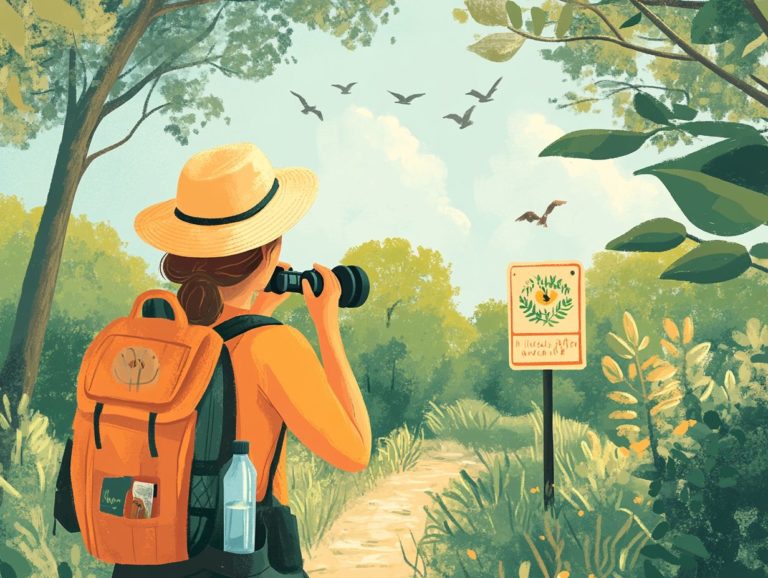How to Choose the Right Spotting Scope?
When it comes to birdwatching, wildlife observation, or long-range shooting, a spotting scope can be your secret weapon, especially if you’re looking for the best image quality!
With many options available, selecting the right one can feel overwhelming.
Let s dive in and discover the must-know factors for getting the best spotting scope!
This guide will cover essential factors to consider, such as magnification power, lens quality, and durability. It will also explore various types of spotting scopes, share practical tips for optimal usage, and provide valuable advice on maintenance.
Explore this guide to elevate your viewing experience with tips on digiscoping using a digital camera to capture images through your scope and camera mounting techniques!
Contents
- Key Takeaways:
- Factors to Consider When Choosing a Spotting Scope
- Types of Spotting Scopes
- How to Use a Spotting Scope
- Maintenance and Care for Your Spotting Scope
- Frequently Asked Questions
- How do I choose the right spotting scope?
- What is the ideal magnification power for a spotting scope?
- How important is the objective lens diameter when choosing a spotting scope?
- Can I use a spotting scope for both hunting and birdwatching?
- What features should I look for in a spotting scope for wildlife viewing?
- What is the recommended budget for a good quality spotting scope?
Key Takeaways:
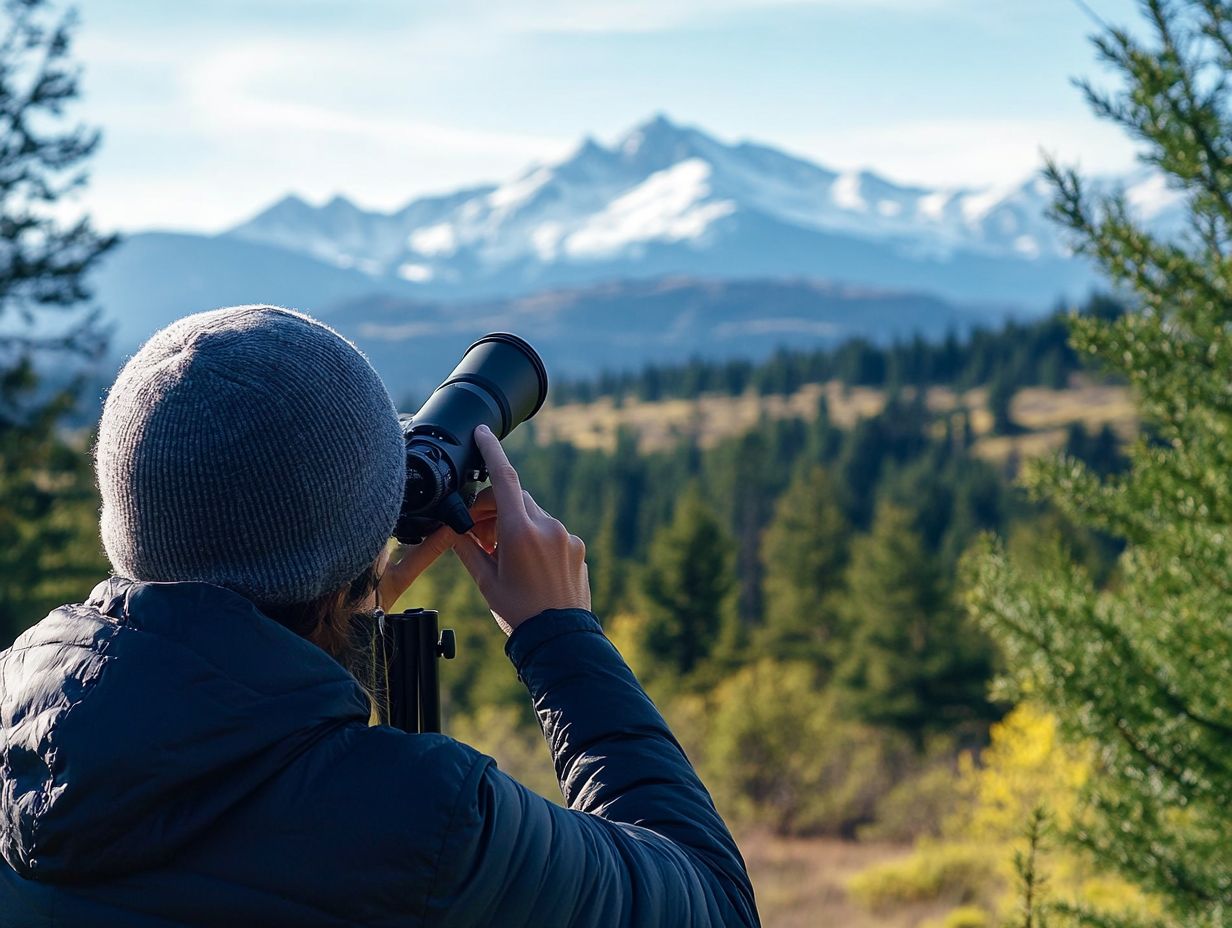
- Consider magnification and lens quality when choosing a spotting scope to ensure clear and accurate viewing.
- Think about size, weight for portability, and weatherproofing for durability in various conditions.
- Proper setup and care, along with understanding different types and features like eyepiece options, will enhance your spotting scope experience.
What is a Spotting Scope?
A spotting scope is an exceptional optical device crafted for long-distance viewing. It is perfect for bird watchers, naturalists, and dedicated hunters like yourself. To learn more about how to choose the right one, check out understanding spotting scopes: a beginner’s guide. It combines strong magnification with high-quality lenses, delivering remarkable image clarity and intricate detail.
Not only does it allow you to observe birds from impressive distances, but it also proves invaluable for wildlife viewing. It grants you insight into animal behaviors without intruding upon their natural habitats.
Good lenses are key for these devices; features like larger lens sizes greatly enhance light-gathering capabilities. The magnification power also influences the scope s adaptability across various environments.
As a hunter, you may find that spotting scopes are critical for identifying game from afar, ultimately ensuring a successful outing. If you’re keen on sharing your experiences, digiscoping techniques enable you to capture stunning images through your scope, beautifully blending technology with the joys of observing nature.
Factors to Consider When Choosing a Spotting Scope
When selecting a spotting scope, several key factors are essential to ensure you find the perfect device tailored to your specific needs. For more insights, consider spotting scope selection factors whether you’re birdwatching, hunting, or engaging in general outdoor activities.
Important considerations include lens quality, magnification, and objective size. The scope’s rugged design and weight also influence portability and ease of use.
It s crucial to evaluate the weatherproof and fog-proof features, as these enhance durability and performance in diverse environmental conditions.
Lastly, keep your budget in mind to ensure you make a choice that balances quality with affordability.
Magnification and Lens Quality
When selecting a spotting scope, prioritize magnification and lens quality. These elements are crucial for ensuring clarity of images and the level of detail you can discern at long distances. For more information, consider the top features to look for in a spotting scope. The scope’s magnification power, often indicated by figures like 20-60x, dictates how closely you can observe distant subjects.
The objective lens diameter plays a significant role in light transmission and the overall brightness of the image.
The quality of lens coatings, including features like ED glass and Bak4 prism systems, further enhances image clarity. This allows you to truly appreciate the beauty of nature or effectively spot game during a hunt.
Understanding how these factors interact is vital for anyone investing in a top-tier optical instrument. Higher magnification offers detailed observation, but without a sufficiently large objective lens to gather light, your images may appear dim and lacking in contrast.
This is where lens quality becomes essential. Premium materials and advanced coating technologies can dramatically boost performance in low-light conditions.
By carefully choosing a spotting scope that strikes the right balance between magnification, objective lens size, and superior lens quality, you can significantly elevate your viewing experience. For more insights, check out understanding spotting scope specifications, whether for birdwatching, wildlife observation, or sports shooting.
In summary, take the time to evaluate your needs and choose a spotting scope that enhances your outdoor adventures by consulting a spotting scope buying guide!
Size and Weight
Size and weight are important factors when selecting a spotting scope, particularly for those who cherish the freedom of portability during outdoor escapades. A lightweight design and compact housing make it easy to transport your spotting scope. Whether you’re hiking through the Great Smoky Mountains or gearing up for a day of birdwatching, knowing how to use spotting scopes for nature observation can enhance your experience. These features play a significant role in tripod stability, which is essential for maintaining a steady view of distant subjects.
These advantages become even more pronounced during long treks, where every ounce matters. Packing minimal gear is crucial, and opting for a spotting scope that is both lightweight and compact allows you to set up quickly. This enables you to capture fleeting moments without the extra weight of heavier equipment.
Many compact models use durable materials that can withstand the demands of outdoor activities, ensuring longevity while preserving ease of use. Ultimately, a thoughtfully designed portable scope not only elevates your viewing experience but also inspires more spontaneous adventures. You can explore freely without being bogged down by your gear!
Weatherproofing and Durability
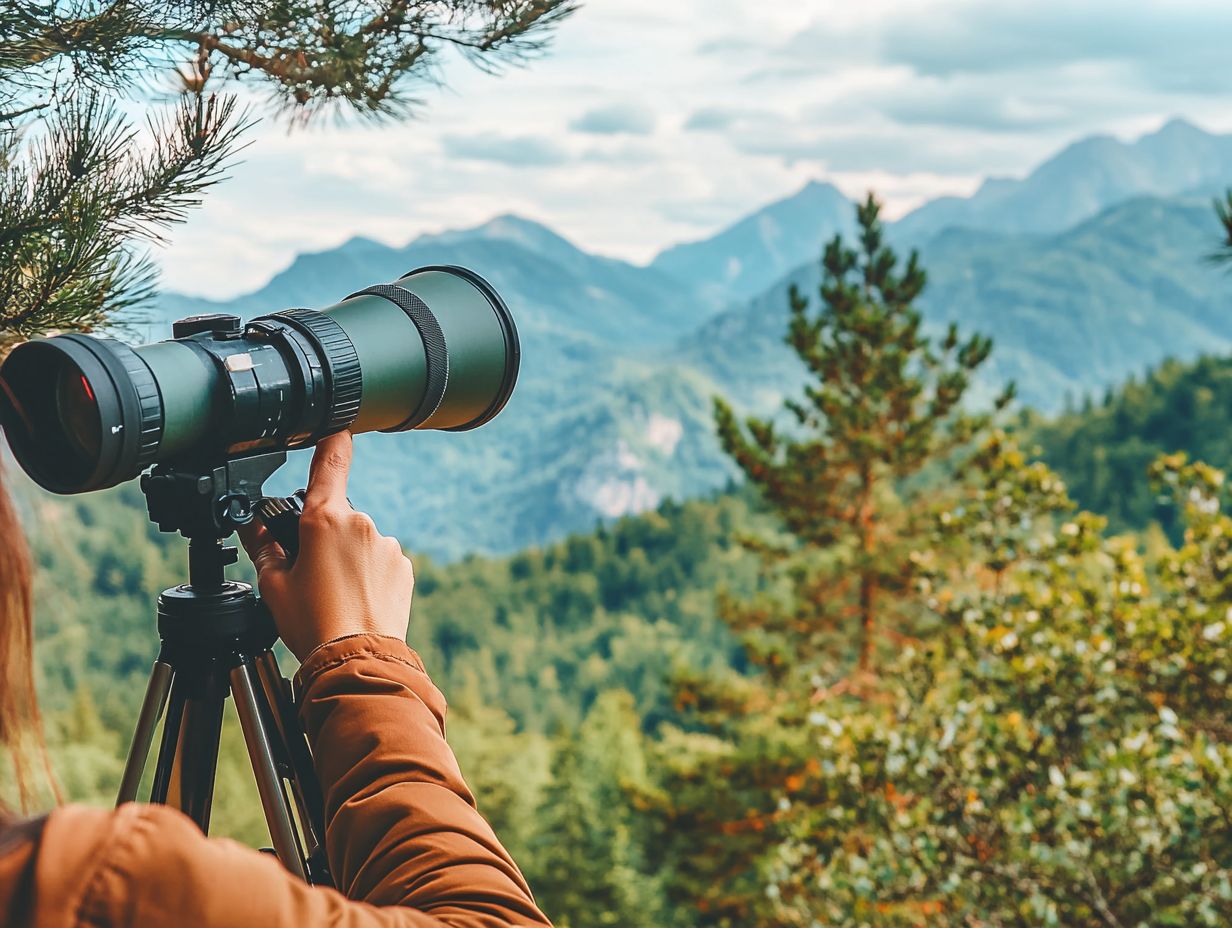
Weatherproofing and durability are key factors to consider when you re choosing a spotting scope, especially if you re the adventurous type who finds joy in the great outdoors where weather can be notoriously fickle. A waterproof and fogproof design means your spotting scope can handle everything from rain to humidity and those pesky temperature swings without sacrificing performance.
This rugged setup ensures you can rely on it, no matter the weather. It makes for the ideal companion for bird watchers, naturalists, and dedicated hunters alike.
These features significantly enhance your experience, allowing you to focus on your observation without worrying about moisture or fog ruining your plans. Investing in a spotting scope with high-quality construction means you re not just purchasing equipment; you re ensuring its usability throughout the year, regardless of the season.
This kind of durability builds trust in your gear, helping it maintain clarity and precision over time. It transforms into an invaluable asset for anyone who thrives on outdoor adventures.
Price and Budget
Price and budget are crucial considerations when selecting a spotting scope, as they can fluctuate significantly based on features, brand, and optical quality. As you navigate this optics purchase, keep in mind not only the initial cost but also the long-term value that high-quality optics and a premium lifetime warranty can provide. For more insights, consider what to consider when buying a used spotting scope. Investing in a reliable spotting scope will elevate your birding and wildlife experiences, ensuring you receive the best image quality and performance for your investment.
Understanding the balance between cost and optical quality is essential for making an informed decision. Often, a higher price tag signifies superior materials and cutting-edge technology, which can dramatically enhance clarity and brightness.
A lower-cost scope might suffice for casual users but could lack the durability and performance needed in challenging conditions. Additionally, warranty options are equally important; scopes with robust warranties offer peace of mind, indicating that manufacturers are confident in the quality of their products.
By evaluating these factors, you’ll ensure that you find a spotting scope that aligns perfectly with both your expectations and budget, especially when it comes to spotting scope optics.
Types of Spotting Scopes
Understanding the various types of spotting scopes is crucial for enhancing your viewing experience, as each type is designed to meet different preferences and applications. Spotting scopes primarily fall into two categories: angled and straight designs. Each offers distinct advantages in usability and comfort, catering to your specific needs.
There are noteworthy differences between prism systems, such as Porro prism and roof prism configurations. Porro prisms provide a wider field of view while roof prisms are more compact. These differences can significantly impact size, weight, and image quality. By diving into these categories, you can confidently select the ideal scope for your birding, wildlife observation, or hunting pursuits.
Straight vs. Angled
Deciding between angled and straight spotting scopes is an exciting choice! It all depends on your personal preference and what you plan to use it for. A straight scope allows for quicker target acquisition, making it a favored option for hunting enthusiasts who need to spot game swiftly.
On the other hand, an angled scope provides a more comfortable viewing angle, especially when you re using a tripod. Each design impacts image clarity and observation techniques, so it s essential to consider your comfort and specific usage scenarios when making your choice.
If you’re often engaged in activities like birdwatching or nature photography, you might find angled scopes to be more ergonomic. They help reduce neck strain during those lengthy sessions. Conversely, if you re focused on high magnification, speed, and linear sighting for instance, as a sport shooter tracking fast-moving targets a straight scope could be your best bet.
Angled scopes reduce fatigue during long viewing sessions. Straight scopes are easier to align for quick target scanning. Ultimately, understanding how each type aligns with your activities can significantly enhance your overall viewing experience.
Porro Prism vs. Roof Prism
Porro prism and roof prism systems are two essential designs in spotting scopes, each with distinct characteristics that significantly influence how well you can see through the scope, including lens coatings and overall form factor.
When weighing your options, it’s crucial to consider how your specific activities will shape your experience. Enjoying the scenery is essential for birdwatchers, naturalists, and serious hunters who value high image quality and a broader field of view. Porro prism systems can be especially beneficial due to their exceptional light-gathering abilities, leading to brighter images and the best image quality, even in low-light conditions.
If you’re seeking a lightweight design for hiking or travel, roof prism scopes might be more your style. Their sleek profile makes for easy packing without sacrificing durability. Each prism design caters to different preferences, enhancing your enjoyment and effectiveness in various observational pursuits.
How to Use a Spotting Scope
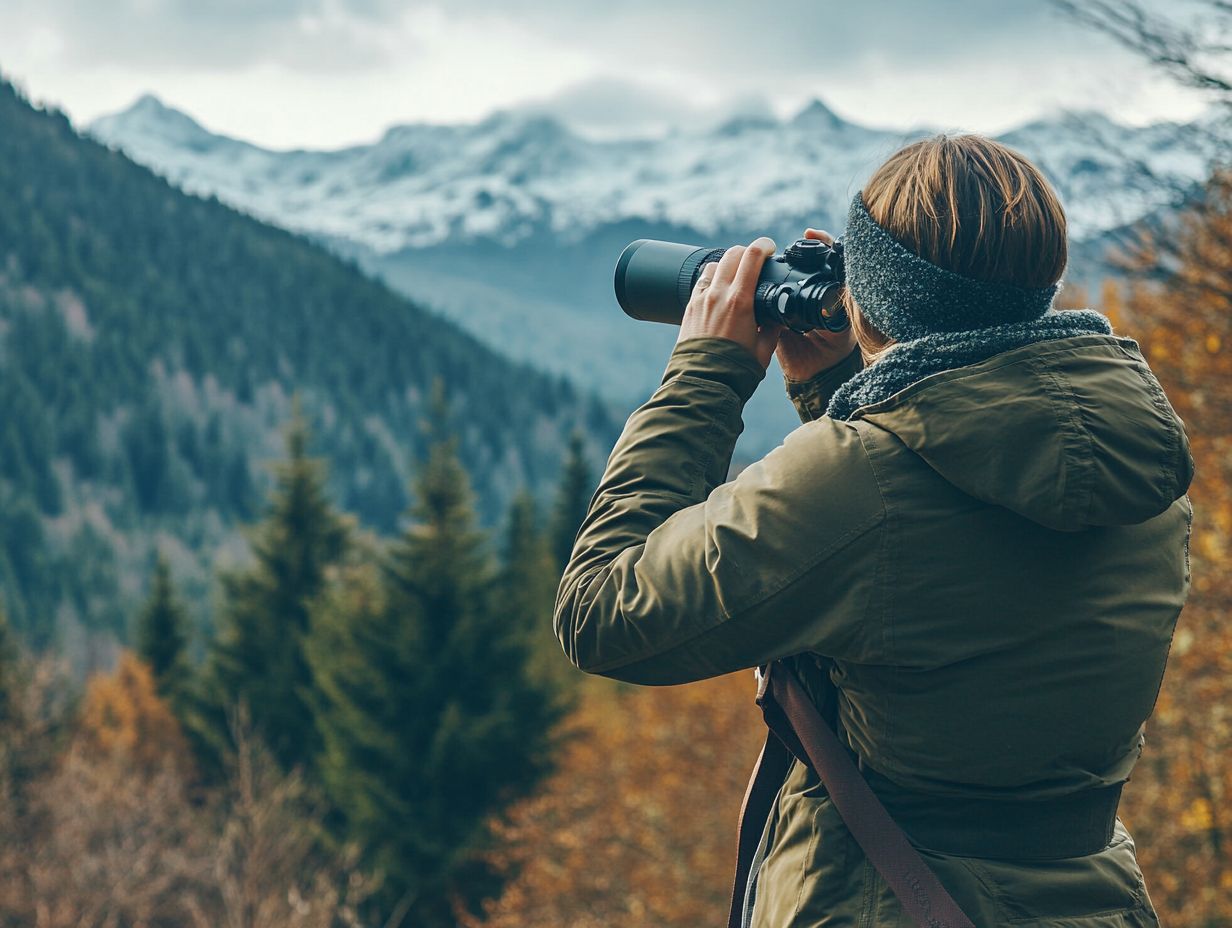
Using a spotting scope effectively requires a keen understanding of its setup and adjustments to enhance your viewing experience, whether you re birdwatching, hunting, or simply enjoying the beauty of nature.
Start by securely mounting your scope on a sturdy tripod. Ensuring tripod stability is essential for achieving the clear, steady images you crave. Familiarize yourself with the focusing mechanism, eyepiece options, and zoom lenses to enhance your viewing experience.
Master the techniques for adjusting the scope according to different distances and subjects. You ll elevate your observational skills and experience with image sharpness and image clarity to new heights.
Setting Up and Adjusting the Scope
Setting up your spotting scope correctly is essential for enhancing your viewing experience. This can make a huge difference in your enjoyment of outdoor activities like birdwatching or hunting. Begin by securely attaching the scope to a sturdy tripod, as stability is key to eliminating vibrations that could muddy the clarity of the image.
Familiarize yourself with the focus mechanism and the various eyepiece options to capture clear, sharp images of those distant subjects.
Adjust the scope’s height so you can look through it comfortably without straining your neck. Position it at a height that aligns with your line of sight. Adjust the angle of the scope for optimal viewing, being mindful to avoid any obstructions in the landscape. Practice focusing on different objects to hone your ability to quickly adjust based on distance.
This hands-on experience will not only enhance your skills but also amplify the joy of your outdoor adventures, whether you’re observing wildlife or identifying distant landmarks. A well-set scope does more than just improve clarity; it enriches the entire outdoor experience, turning each moment into something extraordinary. Don t miss out on capturing those incredible moments in nature; set up your spotting scope today!
Tips for Better Viewing
Enhancing your viewing experience with a spotting scope involves a range of techniques and tips designed to maximize both image clarity and your comfort during extended observation.
One of the best practices is to select a tripod that complements your scope s weight and height. This choice not only stabilizes your view but also significantly reduces fatigue during those lengthy sessions.
Pay close attention to your focusing adjustments to capture crisp details, and don t underestimate the importance of proper lighting. A well-lit environment can dramatically improve clarity.
Exploring digiscoping which combines digital photography with spotting scopes can take your experience to new heights. Capture stunning visuals and share them with friends or your social media followers!
Maintenance and Care for Your Spotting Scope
Proper maintenance and care for your spotting scope are crucial to ensuring its longevity, durability, and peak performance, especially if you often indulge in outdoor activities like birding and hunting.
Regularly clean the lenses and body. This keeps dirt away and preserves image clarity.
Using smart storage methods, like a protective case, can extend your scope’s lifespan. By familiarizing yourself with common issues and fixing common problems, you ll elevate your overall user experience and enjoy every moment spent in the Great Smoky Mountains and the great outdoors.
Cleaning and Storage
Cleaning and proper storage are essential to maintaining your spotting scope, affecting lens quality and durability. Use a soft microfiber cloth to gently clean the lenses, steering clear of harsh chemicals that could damage those delicate coatings.
When you’re not using it, store your spotting scope in a protective case to shield it from dust, moisture, and potential damage, ensuring it s always ready for your next outdoor adventure.
Regularly inspect the scope for any signs of wear or damage, as well as dirt or debris that may accumulate during use. Always check the manufacturer’s recommendations for cleaning solutions to ensure you re using safe products specifically designed for optical equipment, including high-quality optics.
Place desiccants now to keep moisture away and prevent foggy lenses!
By adopting these practices, you can significantly enhance the longevity and performance of your spotting scope, allowing for crystal-clear views with ED glass on every outing.
Common Issues and Troubleshooting
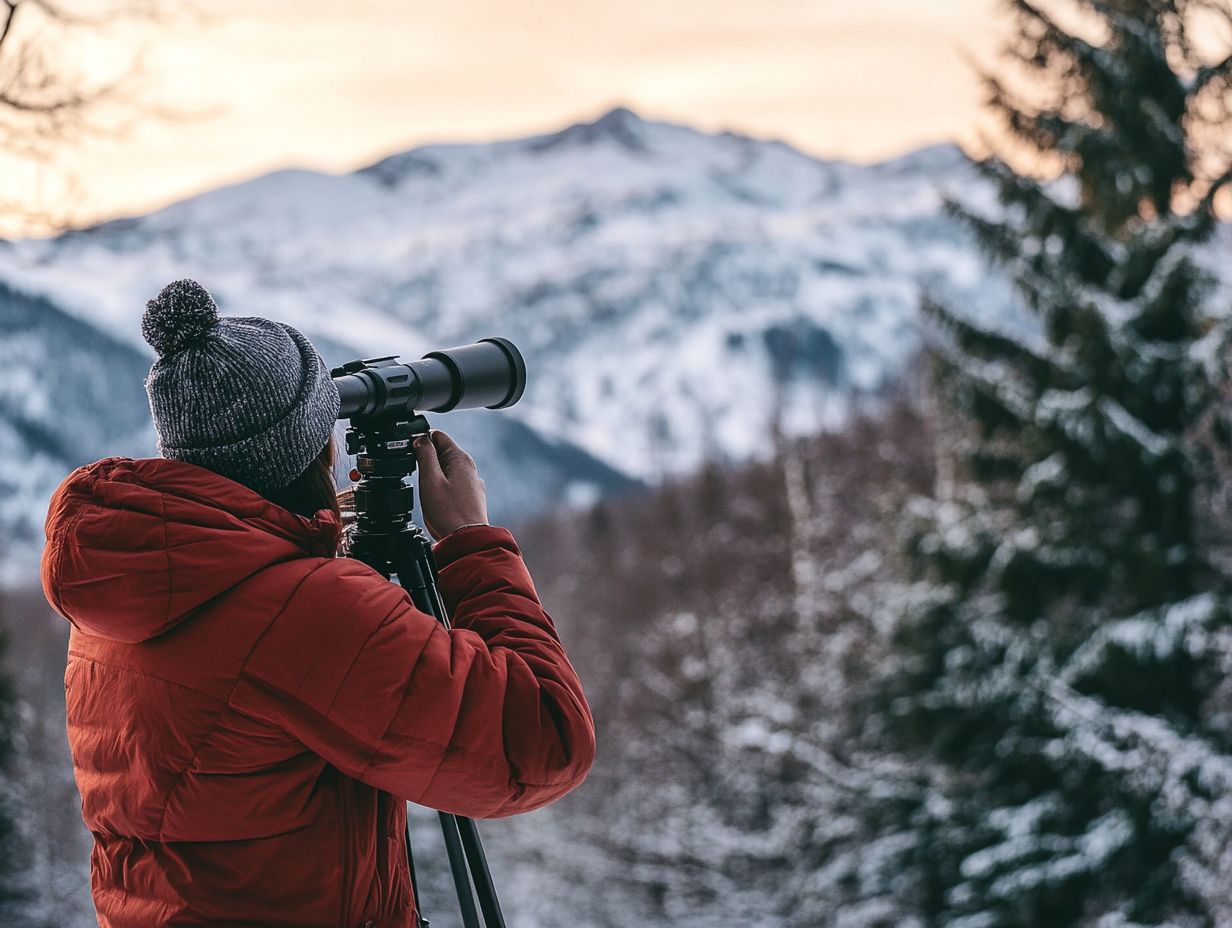
Being aware of common issues and troubleshooting techniques can significantly elevate your experience with a spotting scope, allowing you to efficiently address any problems that may arise during use.
Understanding these challenges enables you to tackle them with confidence. For instance, if you notice a hazy image, check the lens size; it might signal internal fogging due to temperature fluctuations. To remedy this, give the scope time to acclimate before using it, or consider disassembling it for proper drying if necessary. Problems like drifting reticles or loose fittings may simply need a gentle adjustment or a tightening of screws.
Regularly check for proper alignment and ensure all components are securely in place. This can help prevent many of these issues, ultimately preserving both image clarity and overall functionality. Look for hunting gear with waterproof and fogproof designs.
Frequently Asked Questions
How do I choose the right spotting scope?
To choose the right spotting scope, consider the magnification power, objective lens diameter, and price. You should also think about the intended use and features like waterproofing and image quality. For more detailed guidance, check out how to find the right spotting scope for your needs.
Ready to choose your perfect spotting scope? Start exploring today!
What is the ideal magnification power for a spotting scope?
The ideal magnification for a spotting scope varies based on your needs. Generally, a range of 20-60x works best for everyday use.
How important is the objective lens diameter when choosing a spotting scope?
The objective lens diameter is crucial. Bigger lenses let in more light, offering brighter images, but can make scopes bulkier and pricier.
Can I use a spotting scope for both hunting and birdwatching?
Want to use a spotting scope for both hunting and birdwatching? Choose one that balances a wide field of view for birds and high magnification for hunting. For optimal results, check out this guide on how to make the most of your spotting scope setup.
What features should I look for in a spotting scope for wildlife viewing?
Ready to explore the great outdoors? Select a spotting scope that s tough and waterproof. Features like fog-proof lenses and rubber armor enhance durability.
What is the recommended budget for a good quality spotting scope?
A good quality spotting scope typically ranges from $200 to $1000. Beginners can start with budget-friendly scopes and upgrade as they gain experience.


